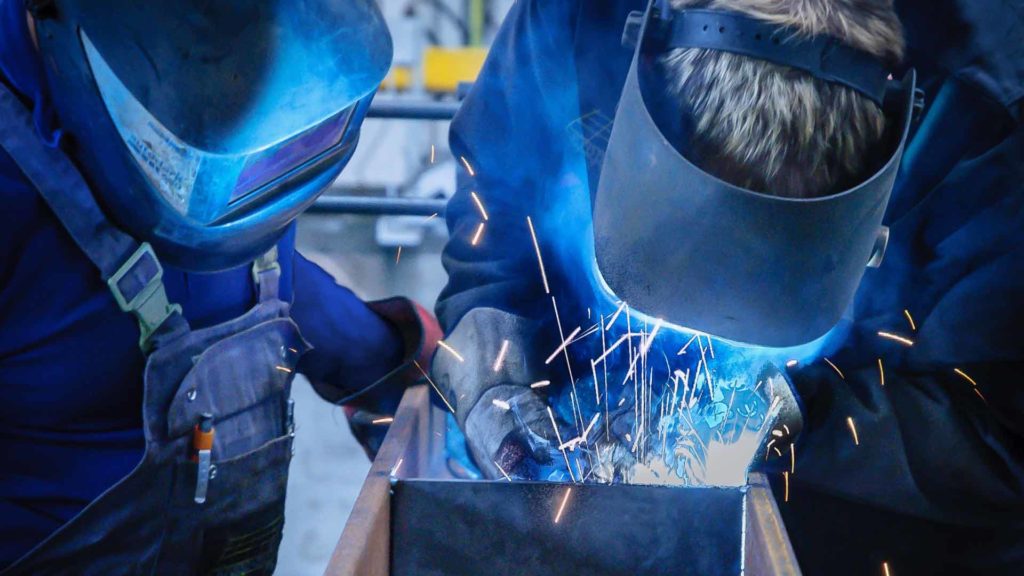Just as the metals and processes that welders use vary from project to project, so do the gases they use. Shielding gases are an important consideration in any welding application. When using a shielding gas mixture, choosing the right gas blend is a critical element that impacts the quality of the weld. In addition to protecting the weld pool from contamination, shielding gas selection also affects productivity.
Bobbi Jo Matheny, Research Associate at the Air Liquide Delaware Innovation Campus, and Jean-Pierre Planckaert, an International Expert in Arc Welding Processes at the Delaware Innovation Campus, understand the importance of shielding gases in maximizing efficiency during welding. “Utilization of the correct shielding gases and mixtures keeps productivity high and costs low by reducing the amount of rework caused by spatter and failed testing,” Matheny says.
Choosing the right shielding gas can be complicated. Matheny notes that there are a variety of chemical considerations involved in choosing the right gases. “Different blends yield different results because of gases’ varying abilities to ionize and carry energy and molten materials across the arc. So, it’s important to know how the shielding pure gas or mixture you’re using will react with the materials in your welding project.” For example, some gases produce welds that are stronger or neater, depending on the requirements of the finished product. Other shielding gases even allow a welder to work on a project out of position.
Argon
In both pure and mixed forms, argon is popular due to its versatility.
Both Matheny and Planckaert note that argon’s low ionization threshold makes it appropriate for many welding applications. According to Planckaert, “Argon’s low ionization potential helps start and stabilize the arc. It is one of the most commonly used shielding gases in either a pure or mixed form.”
However, argon has its limitations. For example, using argon as a shielding gas often yields a penetration profile that has a finger-like shape. Incomplete penetration means that even though there might be a neat bead that gives the illusion of a weld that completely joins two pieces, the weld is not complete and the project is not structurally sound (2017). In addition, an argon arc is not effective for all materials. For example, a pure argon arc is unstable on carbon steel.
Helium
Because helium has no oxidation and does not react with other elements, it can help prevent weld defects.
Adding other gases to argon can help welders reap the benefits of argon gas, such as protection of the weld pool from contamination, without being hindered by poor wetting action. Argon-helium mixtures are typically used for aluminum and titanium alloys. Adding helium creates wetting of the weld pool, which allows for higher travel speeds. In turn, higher travel speeds can help prevent certain weld defects, including burn-through and cold lap (2018). Since helium is an inert gas, it has no oxidation and does not react with other elements. This low reactivity means that helium can help prevent unfavorable chemical reactions from occurring during welding processes.
According to Planckaert, “The higher arc voltage of blends that include helium results in a warmer, more diffused arc that increases penetration and welding speed and improves wetting by providing a flatter bead.”
Carbon dioxide
Carbon dioxide’s oxidation and high ionization potential make it useful for more specific welding applications.
Unlike helium, which has no oxidation and a low ionization potential, carbon dioxide is an oxidizer with a high ionization potential. Carbon dioxide’s high ionization potential makes it useful for short-circuit transfer. This transfer mode, while useful in certain applications, creates increased levels of spatter. Carbon dioxide’s high heat transfer creates deep and wide penetration.
Planckaert says that certain types of welding, like GMAW, require the type of oxidizing atmosphere that carbon dioxide can provide. “The dissociation of carbon dioxide in the arc leads to the formation of oxygen, leading to local oxidation at the surface of the weld pool. The arc is stabilized by emissions from these oxides on the surface of the weld pool.”
Furthermore, carbon dioxide inhibits spray transfer and has very specific applications. Carbon dioxide is typically only used when the properties it creates are necessary for a certain application. Short-circuit transfer, which is used for materials thinner than one-eighth inch, relies on carbon dioxide (2018).
As with any shielding gas, there are caveats to using carbon dioxide. Since the atmosphere of carbon dioxide causes significant oxidation of the metal and a loss of alloying elements, it is important to choose a type of wire that will limit this reaction.
The future of shielding gas mixtures
Understanding how different shielding gas mixtures react with certain materials can be complicated, but industrial gas suppliers can make selecting the appropriate shielding gas mixture easier for welders. Industrial gas suppliers work hard behind the scenes to formulate blends that serve a wide variety of common welding needs. The process behind these formulations requires research, experimentation and field testing.
According to Planckaert, major gas suppliers should work daily to improve shielding gases and their impact on welding. Research should be thorough and include investigation of scientific journals, published research and new and existing patents. Experiments should then be conducted, and when a blend reveals new benefits to the industry, it should be tried and tested in the field to validate its effectiveness and usefulness.


Nice write up. welding electrodes
Great Blog! This post gives a better idea about shielding gases. Thanks for the useful information. I hope you will share some more content. Please keep sharing! industrial gas suppliers in uae